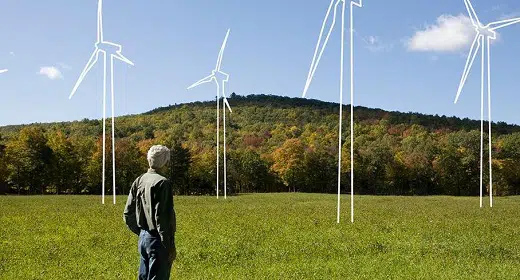by Bridget Reed Morawski: What is Wind Energy?Capable of ecological impacts as diverse as the gentle pollination of wheat and corn to devastating wind storms that keel over trees and homes, wind is all around us. But what actually makes the wind blow?

According to a U.S. Department of Energy webpage, wind is technically a form of solar energy, in the sense that uneven heating of the Earth’s atmosphere is one of three factors causing it. Irregularities of the Earth’s surface — that is, any variation of our topography — and the planet’s rotation. Subsequently, those factors influence how fast and in what direction air in the atmosphere is pushed.
To harness the power from that air movement into mechanical power, wind energy developers typically install massive turbines that rotate like pinwheels across vast swathes of land or sea.
Where Can We Build Wind Farms?

Ted Horowitz / The Image Bank / Getty Images
Americans may be most familiar with the sight of wide-open fields full of wind turbines, but onshore wind farms are only one piece of the wind energy landscape. A significantly smaller but rapidly growing corner of the industry seeks to locate wind turbines in large bodies of water, like lakes and oceans.
In addition to large bodies of water, “the best locations in terms of wind resources are typically high on mountains, in large open fields, or on the edge of bodies of water,” stated a renewable energy consulting firm in a news release in a trade publication. Access to transmission lines is also crucial in order to transport the carbon-free power, often generated in rural or remote areas, to power-hungry, populated urban and suburban centers.
However, while most wind turbines need to be fastened to some sort of stable terrain, another class of wind farms is emerging. Floating offshore wind farms are being pursued in the U.S. and abroad to open up vast tracts of potential new offshore wind areas.
According to one analytics firm’s report, more than 26.2 GW of floating offshore wind capacity has been slated for construction by 2035 across the planet, with developers in countries like Portugal and Japan making arrangements to test the technology.

Aerial view of the construction site of an offshore wind farm, invested by China Three Gorges Renewables (Group) Co., Ltd, on July 15, 2021 in Yangjiang, Guangdong Province of China. Liang Wendong / VCG via Getty Images
Equinor, a major energy developer that historically was a petroleum refiner but has in recent years expanded into offshore wind, built the world’s first floating offshore wind farm in the U.K. in 2017. Since then, it has had the best ratio of actual energy output to maximum possible output compared to any other wind farm in the U.K., according to the Norwegian energy developer.
Within in the U.S., the state of Maine is in the early stages of hosting the country’s first floating offshore wind array in federal waters, a pilot conducted in partnership with a public university and developers. And in California, a state whose coastal waters are generally a lot deeper than those of East Coast states, floating offshore wind farms are being touted as a way for the U.S. to meet its offshore wind goal, as well as for California to hit its own decarbonization deadline.
Which States and Countries Have the Most Wind Farms?
Regardless of location, more than four-fifths of U.S. states had utility-scale wind power projects, meaning the power generated was large enough to impact an electricity grid’s operations. Despite the Midwest’s fossil-fuel-heavy reputation, the five states that generated the most wind energy in 2020 were Texas, Iowa, Oklahoma, Kansas and Illinois, representing more than half the country’s total wind generation, according to a U.S. Energy Information Administration webpage.
Very few megawatts are currently generated by U.S. offshore wind projects, like Rhode Island’s 30 MW Block Island Wind Farm, at the moment. However, numerous projects, including the recently approved Vineyard Wind I, which will deliver hundreds of megawatts to the regional grid, are in various development stages at the moment.
Wind farms in the U.S. generate about one-fifth of the entire planet’s wind-based electricity. However, China leads the world in wind-based electricity generation, with more than double what the U.S. produces. From there, Germany, India and the U.K. round out the top-five wind energy-producing countries.
But the countries with the largest amounts of installed wind turbines aren’t necessarily the same nations that have the greatest wind energy generation potential. For example, Russia, Somalia, Oman, Vietnam, Iceland and Kazakhstan all have “little or no installed wind farm capacity” compared to their actual potential, according to an energy news project sponsored in part by the Spanish Wind Energy Association.
Purported Problems With Wind Energy

A red kite (Milvus milvus) flies in front of a wind turbine on May 24, 2020 in Brandenburg, Sieversdorf. Patrick Pleul / Picture Alliance via Getty Images
Although the energy source doesn’t emit greenhouse gases during power generation, the industry has its own set of complications.
Flying Animal Deaths and Habitat Disruption
Active wind farms do kill flying animals, like birds and bats, but not in the same way. While birds are killed when a blade strikes them, bats die when “the pressure wave from the turning blades hits [them] and damages their internal organs,” according to an Oregon State University webpage.
The American Bird Conservatory examined multiple studies and found that estimates range from at least 140,000 birds killed by wind turbines annually up to potentially 679,089 birds. And wind turbines have been called the greatest threat to bats in the U.S., resulting in industry trade group guidelines meant to reduce fatalities through actions like slowing down turbine speeds.
However, researchers are actively testing detection and monitoring technologies to limit the number of avian and bat deaths by wind turbine strikes, as well as evaluating the carcasses of dead animals near turbines to evaluate which species are prone to being hit. Other techniques, like painting wind turbines black, have been considered to minimize strikes and deaths.
Additionally, wind farm construction and ongoing generation activities can result in habitat loss for flying as well as land-based creatures. In the U.S. West, a bird known as the sage grouse requires vast stretches of sagebrush, but wind farms break that habitat up into smaller parcels. Migratory soaring birds, like black kites, also lose habitat when they are forced to fly around wind farms.
Wind Turbine Recyclability
Another complaint of the wind energy industry is that the massive blades that spin to create that power aren’t eco-friendly. The blades are more than 100 feet long so it’s not easy to bring them to the location in the first place. But taking down a wind turbine, built to withstand extreme weather conditions, means cutting up the blades and hauling them to a landfill for burial.
Companies with a stake in the success of the industry say their staff are working to recycle the wind turbine blades. For example, GE Renewable Energy and Veolia North America announced in late 2020 that the companies were working together to develop circular recycling for wind turbines, the first-such program in the country.
Space Requirements
Weighing more than 1,000 tons, wind turbines can be hundreds of feet tall with blades longer than football fields. According to Arcadia, an energy company, a single MW of onshore wind energy requires up to 50 acres of space.
Even on the open ocean, problems related to the location and space requirements of offshore wind farms have arisen. Fishermen in the Gulf of Maine, for example, have protested offshore wind development in part due to navigation concerns.
That requirement to operate on vast bundles of open space is a dealbreaker for some opponents, particularly those who want to use that land for other purposes.
“Wind resource development might not be the most profitable use of the land,” notes the U.S. Department of Energy on a webpage. “Land suitable for wind-turbine installation must compete with alternative uses for the land, which might be more highly valued than electricity generation.”
While farmland communities, in particular, have been wary of the amount of potentially fertile land being used for immense wind farms, dual-use projects have increasingly been part of the wind energy conversation. According to a 2018 white paper written by a lecturer at the University of Michigan’s Ford School of Public Policy, wind energy should be viewed as a key farmland preservation method, as the lease payments that an energy developer makes to small-time landowners can help bridge financial gaps and bring more cash to the local economy.
Transmission Constraints
Because of the gigantic amount of space needed for a wind farm, naturally it’s difficult to site a wind farm too close to a developed urban center that doesn’t have plenty of empty acres on which to build. Yet rural areas historically have had issues with sufficient transmission infrastructure, meaning that there aren’t enough poles, power lines and similar structures to convey all the power generated at a wind farm to the places that want all of that electricity.
Similar issues present themselves in regards to offshore wind transmission.
The federal government has previously issued reports explaining that a third of the entire country’s power demand could be satisfied by wind energy if enough new transmission was built.
However, “in the baseline scenario with no transmission expansion, substantial renewable energy curtailment—times in which wind farm operators are told not to produce energy due to limited capacity on the grid—could become a major issue,” the report notes. “In this scenario, about 15.5% of wind energy capacity goes unused with consequent increases in system costs as a result of idled wind generation.”
Further, the federal study also found that “if just four currently proposed transmission projects [as of 2017] are built, wind curtailment can be reduced by about half, cutting lost generating potential to 7.8%.”
Shadow Flicker and Noise Complaints
Some people who live adjacent to wind farms complain about the flicker effect of the shadows cast by rotating wind turbine blades when the sun is low in the sky.
“Although in many cases shadow flicker occurs only a few hours in a year, it can potentially create a nuisance for homeowners in close proximity to turbines,” notes a U.S. Department of Energy webpage. Some people living near wind farms or turbines have reported getting headaches from the flicker, while others complain about the noise levels.
However, studies have been undertaken to examine any correlation between health impacts and wind turbines or their flicker and turbine noise have come up with little evidence beyond stress and annoyance.
A 2019 position statement, drafted after officials in San Diego County, California, examined available published research, notes that “the majority of evidence shows that, while noise from wind turbines is not causally related to adverse health effects, wind turbines may be a source of annoyance for a small minority of community residents. That annoyance may cause stress for these individuals, and that stress may be associated with certain reported health effects.”
However, the statement continued, “the weight of evidence suggests that, when sited properly, wind turbines are not related to adverse health effects.”
Intermittency
Despite predictive modeling technologies that generally provide developers with knowledge of what the wind resource in a given area is like, wind speeds can change quickly and without much notice. That intermittency makes it more difficult for grid planners to know exactly how much power will be transmitted onto their systems by a particular wind farm or turbine.
Because of that variability, reserve capacity is used as a buffer in case insufficient energy comes into the grid. Conversely, battery storage systems are increasingly being constructed alongside renewable energy projects like wind farms in order to store and later take advantage of excessive wind energy output.
Interestingly, a 2015 article in Scientific American suggests that the larger a wind farm is, the less corresponding reserve capacity is needed.
“While at first glance it might sound like adding too much renewable energy could destabilize the delicate balance of the electric grid, it turns out that renewable energy actually becomes more predictable as the number of renewable generators connected to the grid increases thanks to the effect of geographic diversity and the Law of Large Numbers,” according to the article.
U.S. Wind Development Plans

A Joshua tree stands out against a backdrop of Manzanas wind turbines near the Tehachapi Mountains on February 16, 2021 in Rosamond, California. Gina Ferazzi / Los Angeles Times via Getty Images
Earlier this year, President Joe Biden declared a new renewable goal for the country: 30 GW of offshore wind energy by 2030. Procuring that amount of offshore wind energy would mark a major step toward achieving the overall federal goal of 100% clean energy procurement by 2035.
Before that announcement, the offshore wind energy industry had already been heating up along the East Coast, particularly in the Northeast. Supportive state governments in the Mid-Atlantic up through New England have generally rolled out the red carpet for the industry, attracted to the promise of reliable, high-paying jobs for their constituents and a boost to their own state decarbonization goals.
Yet even in states that want offshore wind, traditional local industries accustomed to having full access to different parcels of land and sea are up in arms over sharing space with the wind industry.
For example, the state of Maine may be eager to seize the opportunities inherent in building up a major nascent energy industry but has needed to respond to local concerns regarding how the new industry may limit profitability in existing sectors. To that end, the governor recently signed legislation barring new offshore wind development in the state’s waters for a decade in a major concession to the state’s lobster fishing industry.
Despite local red tape, the wind industry made immense progress in 2020, according to a trio of reports released by the federal government just this week to highlight the sector’s achievements.
Overall, “a record 16,836 MW of new utility-scale land-based wind power capacity [were] added in 2020 – representing $24.6 billion of investment in new wind power projects,” according to an accompanying press release,” noting that turbine prices also “steeply declined from levels seen a decade ago, from $1,800 per kilowatt in 2008 to $770–$850 per kilowatt now.”
Despite the federal government’s support, other national priorities can sometimes conflict with the push for wind power growth. For example, the U.S. Navy has previously created major hurdles for offshore wind development off California’s Pacific Coast due to their preference that there are zero potential obstacles for their ships.
Bridget is a freelance reporter and newsletter writer based in the Washington, D.C., area. She primarily writes about energy, conservation and the environment. Originally from Philadelphia, she graduated from Emerson College in 2016 with a degree in journalism and a minor in environmental studies. When she isn’t working on a story, she’s normally on a northern Maine lake or traveling abroad to practice speaking Spanish.
















































